

Natural Ways to Ease Hip Pain Discomfort at Home
Hip pain can disrupt your daily life, making even simple movements a challenge. Fortunately, you don’t have to rely solely on medication to find relief. There are several natural at-home remedies that can ease discomfort, improve mobility, and support long-term joint health.
From heat and cold therapy to anti-inflammatory foods and gentle exercises, these strategies are safe, accessible, and effective. Whether you’re recovering from an injury or managing chronic pain, this guide offers natural ways to ease hip pain discomfort at home that promote healing and help you regain control over your comfort and movement.
1. Rest and Activity Modification
One of the first steps in managing hip pain is allowing your body time to rest. Resting the affected hip helps reduce inflammation and prevents further strain or injury. However, rest doesn’t mean complete immobility. It's about modifying your activities to avoid unnecessary stress. Try to limit movements that involve deep bending, squatting, or heavy lifting, which can worsen the pain.
When it comes to sleep, your position can make a big difference. Avoid lying on the affected side, as it puts direct pressure on the hip. Instead, sleep on your back or the opposite side, placing a pillow between your knees for better alignment and support. If pain persists despite lifestyle adjustments, it may be time to explore options like physiotherapy or even look into how to choose the right pain management clinic that offers personalized treatment plans.
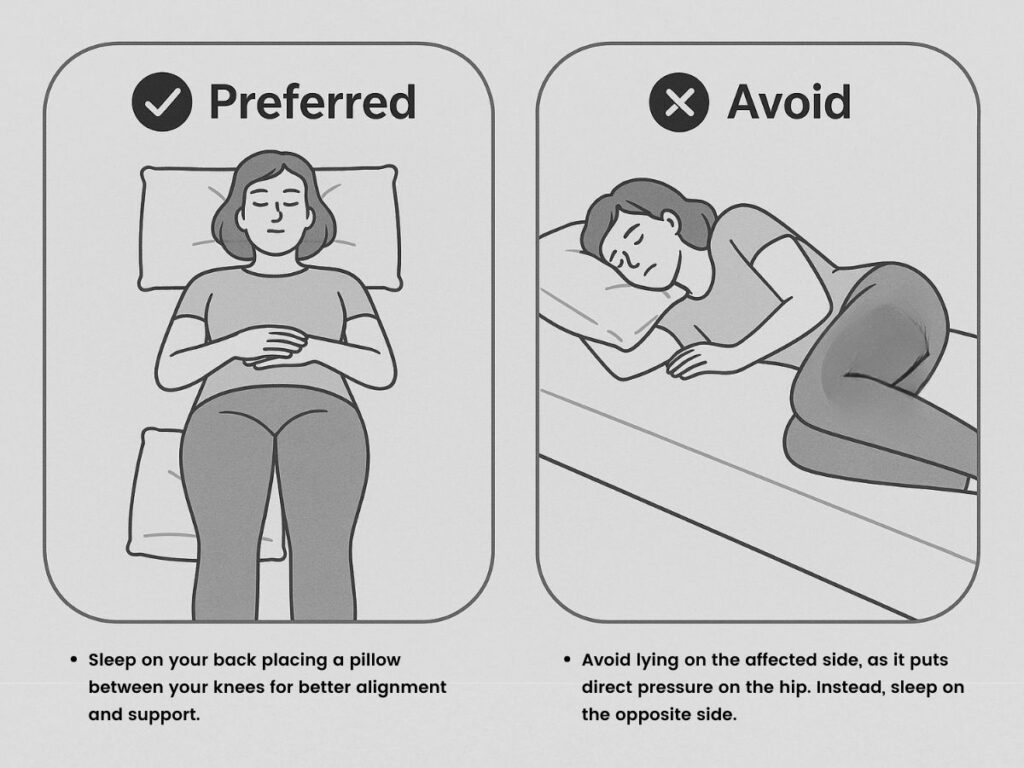
2. Hot and Cold Therapy
Hot and cold therapy is a classic yet powerful pain management tool. Applying cold packs to the hip helps constrict blood vessels, reduce swelling, and numb sharp pain. Wrap an ice pack in a towel and apply it to the hip for 10–15 minutes at a time, especially after the activity.
In contrast, heat therapy works wonders for relaxing tight muscles and boosting blood circulation. Use a heating pad or hot water bottle, or take a warm bath for about 15–20 minutes to soothe soreness and stiffness. Exploring the benefits of heat and cold therapy for pain relief can help you tailor treatments to what works best for your body. For maximum relief, alternate between hot and cold therapy throughout the day. Just be sure to leave enough time between sessions to prevent skin irritation.
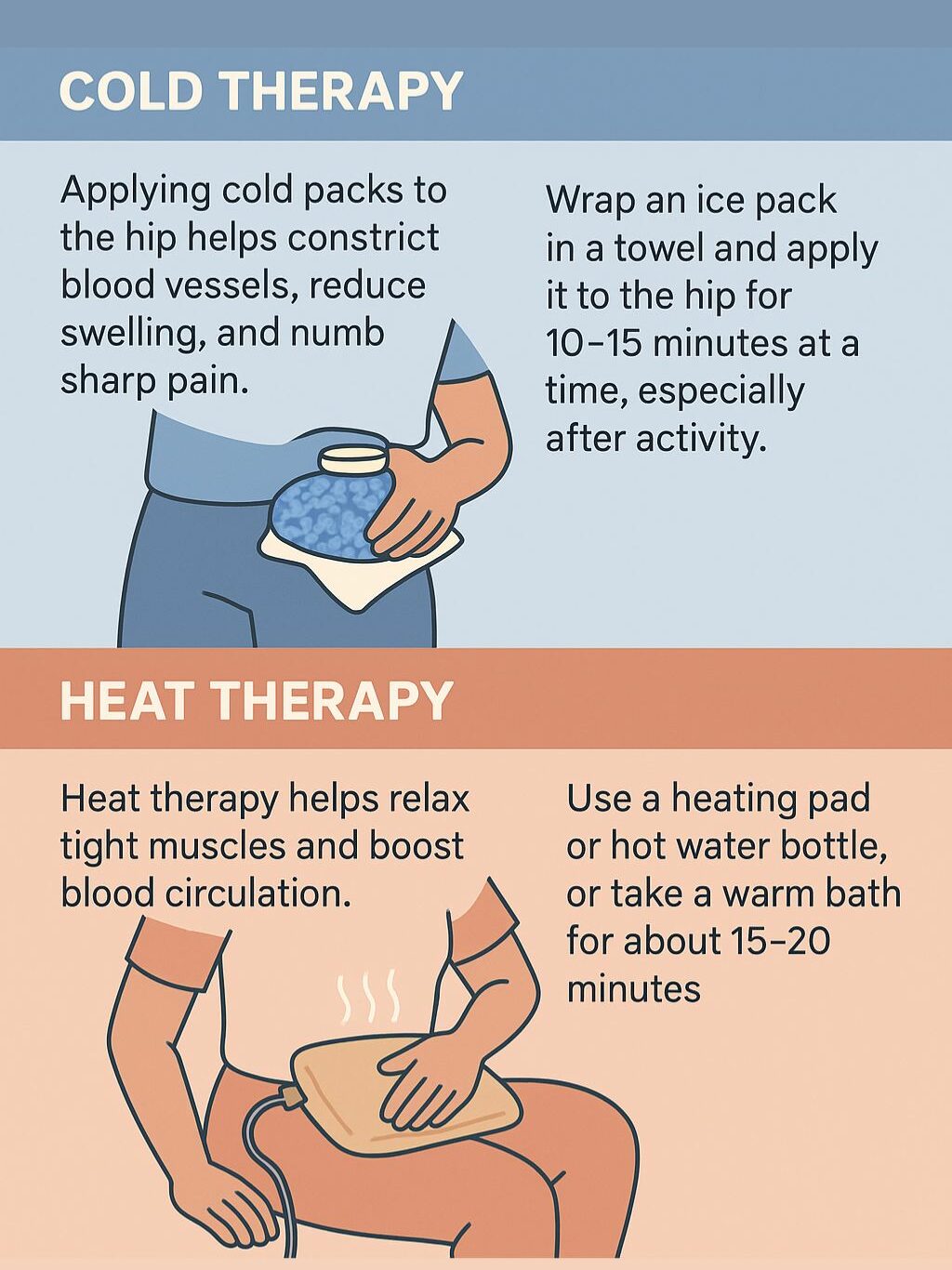
3. Gentle Stretching and Exercise
Incorporating gentle stretching and low-impact movement into your routine can help increase flexibility, reduce tension, and improve hip mobility over time. Stretching areas like the hip flexors, hamstrings, and glutes can offer significant relief.
Low-impact activities such as walking, yoga, swimming, and tai chi are also excellent options to keep joints moving without overloading them. These exercises are often part of personalized routines in pain management for athletes, who need to stay active while protecting vulnerable joints. The key is to start slowly and listen to your body—avoid overstretching or engaging in high-impact sports that could aggravate the joint.



4. Compression and Support
Compression can provide additional support to an aching hip. Using elastic compression wraps or supportive braces helps stabilize the joint and may reduce swelling by improving circulation.
Footwear also plays a surprisingly large role in hip health. Shoes with proper arch support and cushioning reduce pressure on the hips by promoting better posture and shock absorption. Avoid flat shoes or high heels—opt instead for orthopedic or well-cushioned athletic shoes for daily wear.
5. Natural Supplements and Anti-Inflammatory Foods
Diet and supplements can also play a role in managing inflammation naturally. Ingredients like turmeric, ginger, MSM (methylsulfonylmethane), and shark cartilage have been suggested to help reduce joint pain and stiffness. These natural anti-inflammatories can be taken in capsule form or added to meals—but always consult your healthcare provider before starting any new supplement.
Your diet matters, too. Eating foods rich in antioxidants, vitamins, and minerals can help your body fight inflammation from the inside out. If you're looking to make lasting dietary changes, consider picking up an anti-inflammatory cookbook that includes joint-friendly recipes to support hip health. Incorporate colorful fruits and vegetables, nuts, seeds, and fatty fish into your meals to support overall joint health.
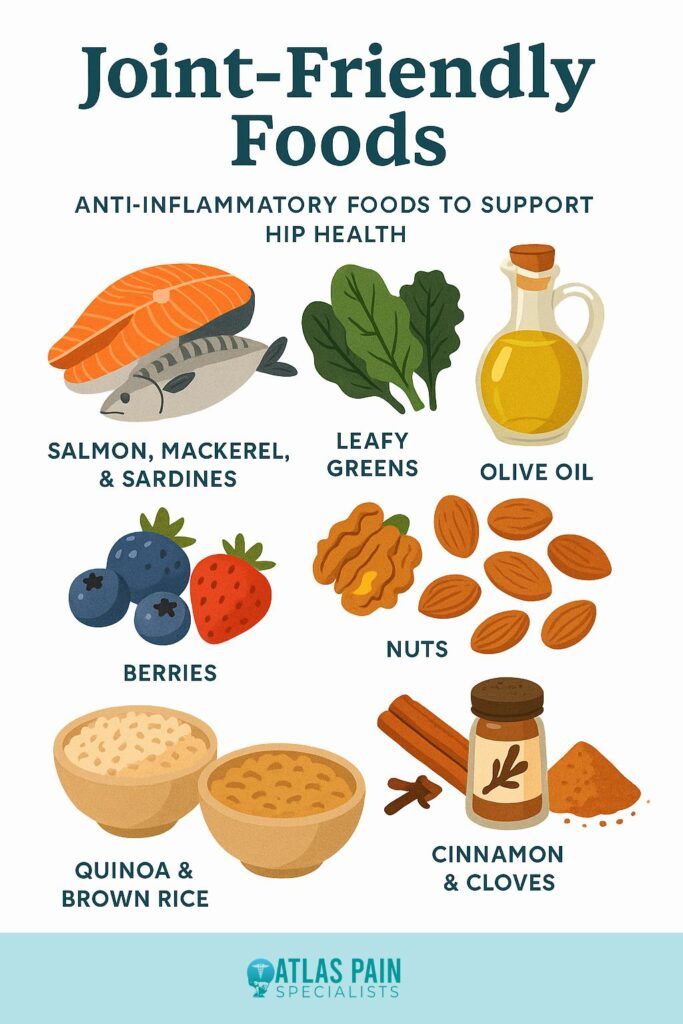
6. Massage and Manual Therapies
Massage therapy can be incredibly effective in reducing hip discomfort. By improving blood flow and relaxing tight muscles, massage helps ease tension in surrounding areas such as the glutes, lower back, and thighs—all of which can impact hip function. Increased circulation also promotes healing and reduces stiffness.
For home care, self-massage is a practical option. Using tools like a foam roller, massage ball, or even your hands, you can gently target areas around the hip to release knots and reduce muscle tension. Roll slowly over tender spots for 30–60 seconds, being mindful not to apply too much pressure.
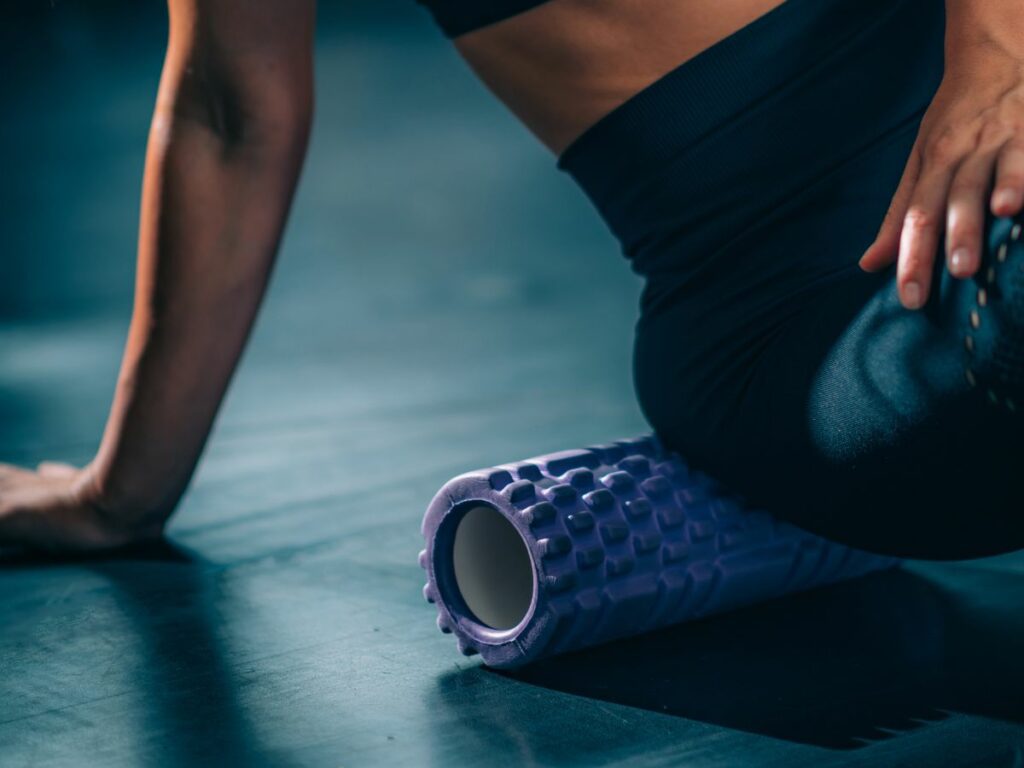
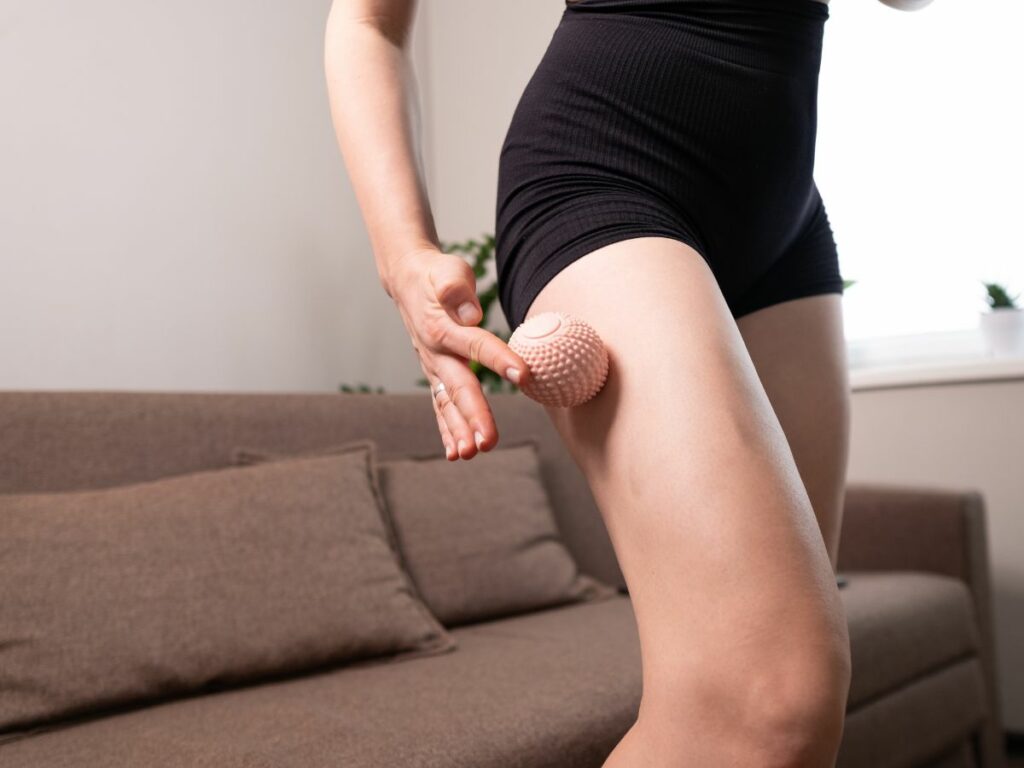
Another complementary approach worth exploring is reflexology. This involves applying pressure to specific points on the feet, which correspond to various organs and body parts. While not a direct treatment, many people find reflexology sessions deeply relaxing and helpful for managing chronic pain.
7. Lifestyle and Ergonomic Adjustments
Sometimes, small changes in daily habits make a big difference in managing hip pain. One of the most effective lifestyle steps is maintaining a healthy weight. Extra pounds put added stress on your hip joints, accelerating wear and tear. Even a modest weight loss can improve mobility and reduce discomfort.
Your posture and ergonomics also play a major role. When sitting, ensure your hips are slightly higher than your knees and avoid slouching. When standing or walking, keep your spine neutral and distribute your weight evenly. If your job involves lifting, bend at the knees—not at the hips—to avoid strain.
In some cases, assistive devices like a cane or walker may help offload the hip, especially during flare-ups. These tools can prevent falls and provide extra stability, allowing you to move with more confidence and less pain.
8. Mind-Body Practices for Pain Management
Pain isn’t just physical—it’s also emotional and psychological. That’s where mind-body practices come in. Techniques like deep breathing, mindfulness, and progressive muscle relaxation can help shift your focus away from pain and reduce tension throughout your body.
Regular meditation or guided imagery sessions—even just 5–10 minutes a day—can lower your stress levels and change how your brain perceives pain. Gentle yoga practices, which combine movement with breath awareness, are particularly beneficial for building flexibility and calmness without overexertion.
Frequently Asked Questions (FAQ)
1. What is the best sleeping position for hip pain relief?
The ideal position is sleeping on your back or on the side opposite the affected hip. Placing a pillow between your knees can help align your hips and reduce pressure, improving comfort and reducing morning stiffness.
2. How long should I use hot or cold therapy on my hip?
Use cold therapy for 10–15 minutes to reduce inflammation, especially after activity. Heat therapy can be applied for 15–20 minutes to relax muscles. Always allow your skin to rest between sessions to avoid irritation.
3. Are natural supplements really effective for hip pain?
Some people find relief from supplements like turmeric, MSM, and ginger due to their anti-inflammatory properties. However, effectiveness varies from person to person, and it’s best to consult your doctor before starting any new supplement.
4. Can exercise make hip pain worse?
Yes—if it’s high-impact or too intense. But gentle, low-impact exercises like walking, yoga, or swimming can improve mobility and ease stiffness. The key is to start slowly and listen to your body.
5. When should I see a doctor about hip pain?
If your hip pain is severe, lasts more than a few weeks, or is accompanied by swelling, redness, or reduced mobility, it’s best to consult a healthcare provider. Persistent pain could indicate an underlying issue that needs professional care.
Conclusion
Living with hip pain doesn’t mean giving up your independence or peace of mind. By incorporating natural therapies like massage, mindful stretching, ergonomic changes, and an anti-inflammatory diet, you can reduce discomfort and improve your overall quality of life.
These strategies not only treat the symptoms but also support your body’s natural healing process. Remember, consistency is key—and if pain persists, consult a healthcare .professional for tailored support. Embracing these holistic solutions empowers you to take control of your well-being one small, steady step at a time.
About Dr. Sean Ormond



